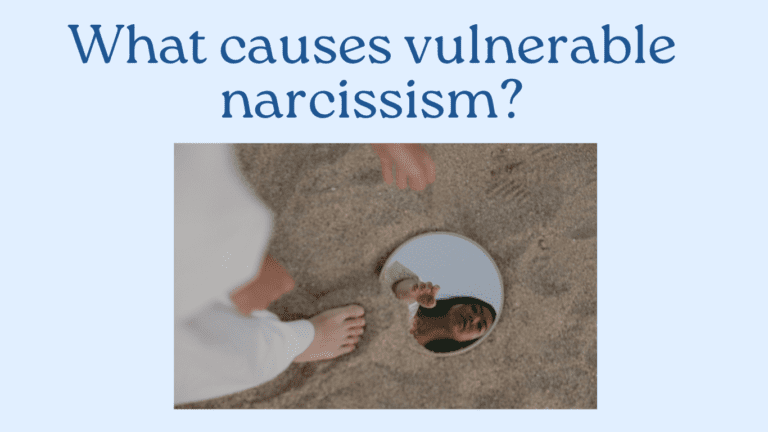I have a vulnerable narcissist in my life, and it makes me wonder: What causes vulnerable narcissism?
While the exact causes aren’t fully understood, research suggests that it may result from a combination of genetic, environmental, and psychological factors.
In this post, we’ll explore the key contributors to vulnerable narcissism and how they might come together.
What is Vulnerable Narcissism
Vulnerable narcissism, also called covert narcissism, is a subtype of narcissistic personality disorder. It involves fragile self-esteem, extreme sensitivity to criticism, and social withdrawal. Despite this, there is an underlying sense of entitlement and self-importance.
Unlike grandiose narcissists, they seem shy, insecure, or self-effacing but still possess deep narcissistic traits.
What causes vulnerable narcissism?
Early Childhood Experiences
- Parental Expectations and Pressure
Parental pressure and unrealistic expectations can plant the seeds of vulnerable narcissism.
When parents prioritize achievement, perfection, or external validation over emotional support, a child learns that their worth depends on success.
As a result, this belief creates fragile self-esteem and extreme sensitivity to criticism. They start feeling valuable only when they excel, making failure or rejection especially painful.
At the same time, constant pressure can foster a hidden sense of entitlement. The child may think, “I work so hard, so I deserve special treatment.” But when they fall short, that entitlement turns into deep shame.
This cycle of striving, entitlement, and insecurity can shape the traits of vulnerable narcissism.
- Childhood Neglect or Emotional Unavailability
Childhood neglect or emotional unavailability can contribute to the development of vulnerable narcissism. When caregivers are dismissive, indifferent, or inconsistent, a child may feel unworthy and unseen. As a result, they develop deep feelings of inadequacy and unmet needs.
To cope, they may develop an inflated sense of self-importance as a defense, believing they deserve the attention they never received. This defense mechanism creates a fragile ego that swings between emptiness and entitlement.
Lacking secure attachment, they become preoccupied with self-worth, constantly seeking validation while resenting those who withhold it. This cycle reinforces their emotional instability and the traits of vulnerable narcissism.
- Traumatic Childhood Experiences
Traumatic childhood experiences—such as abuse, sexual assault, bullying, or chronic instability—can fuel vulnerable narcissism. These events shatter a child’s sense of safety and self-worth, leaving deep emotional wounds and a fractured identity.
When a child is repeatedly hurt or betrayed by those they depend on, they may develop a defensive self-focus. They swing between feelings of victimization and fantasies of superiority to cope with powerlessness.
The trauma creates a persistent need for validation to counteract shame while also fostering mistrust and hypersensitivity to criticism. Any perceived rejection can reignite childhood wounds.
This combination of emotional fragility and entitled self-absorption forms the core of vulnerable narcissism. Grandiosity masks profound insecurity, and relationships become battlegrounds for unmet needs and unresolved pain.
Sociocultural and Environmental Factors
- Media and Social Comparison
Exposure to media and constant social comparison can worsen narcissistic traits by promoting unrealistic self-views and dependence on external validation.
Platforms like Instagram and TikTok, which highlight curated perfection, status, and instant approval, make people judge their worth based on likes, followers, and shallow measures. This leads to feelings of inadequacy when they don’t measure up.
For those with fragile self-esteem, this environment provokes envy, self-absorption, and defensive grandiosity. They may feel inferior to others’ highlight reels or create an inflated self-image to cope.
The pressure to perform and the shame of falling short deepen their hypersensitivity to criticism, fear of irrelevance, and need for admiration.
- Bullying and Emotional Vulnerability
Bullying shapes vulnerable narcissism by reinforcing feelings of powerlessness.
Victims internalize humiliation and rejection, leading to persistent inadequacy. At the same time, they may develop an inflated sense of uniqueness, believing they are special because they’ve suffered more.
This duality, feeling inferior yet entitled to special consideration, strengthens hypersensitivity to criticism and resentment of perceived slights.
They switch between self-pity and grandiose fantasies. The lack of protective support during bullying heightens emotional vulnerability. It teaches them that relationships are unsafe and that self-worth must be fiercely defended.
Over time, this creates a fragile ego that craves constant validation but remains perpetually wounded, seeing the world as both an audience and a threat.
Self-Concept and Identity Struggles
- Fragile Self-Image and Lack of Self-Awareness
Vulnerable narcissists struggle with unstable self-worth, swinging between insecurity and defensive grandiosity while lacking self-awareness.
When core self-worth is unstable, but self-awareness is low, people develop three damaging coping mechanisms:
- Hypersensitivity to criticism (perceiving threats everywhere)
- Covert grandiosity (clinging to “specialness” to compensate for shame)
- Externalizing blame (protecting their ego by chronically playing the victim)
These adaptations create the main traits of vulnerable narcissism: An intense need for validation paired with resentment and self-absorption that sabotages the very relationships needed for healing.
In essence, the mind creates a narcissistic defense system to shield against the terror of feeling insignificant. But these coping strategies only reinforce isolation and a distorted self-view.
- Internal Conflict Between Authentic Self and Idealized Self
The conflict between the authentic self (true feelings, flaws, and limitations) and the idealized self (a perfect image) can cause vulnerable narcissism.
When these opposing forces fail to integrate, self-doubt mixes with fantasies of superiority, creating hypersensitivity to criticism.
Externally, they crave validation to stabilize their fragile self-worth, but their grandiose expectations clash with reality.
This triggers cyclical transitions between entitlement and shame. To cope, they weaponize passivity: Adopting victimhood to seek sympathy, nurturing envy to justify resentment, and hiding superiority behind false humility.
Conclusion
Vulnerable narcissism originates from childhood injuries—parental pressure, neglect, trauma, and sociocultural influences. These experiences create fragile self-esteem and a constant hunger for validation.
However, healing is nearly impossible because they’re too consumed by their inner conflicts to recognize the need for change.
Trapped in a cycle of defensiveness and self-absorption, they can’t truly hear or process attempts to help. Even when you offer compassion or guidance, they may misinterpret or dismiss it.
They must be willing to face their pain and develop the self-awareness necessary for growth, and without that, any efforts to fix them will be draining and fruitless.
In the end, healing is something they must choose for themselves.
Also read: 20 Facts About Narcissists: A Vulnerable Narcissist Checklist For Letting Go



Pingback: Narcissist MBTI: 6 MBTI Types Most Likely to Show Narcissistic Traits - Vulnerable Narcissist
Pingback: Are Narcissists Evil or Just Broken? - Vulnerable Narcissist